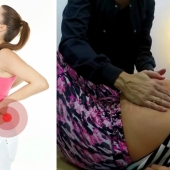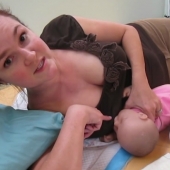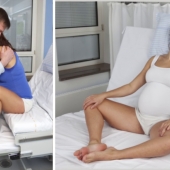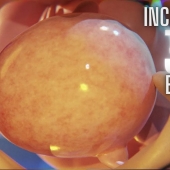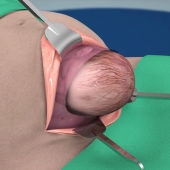To accommodate itself to the maternal pelvic dimensions, the fetus must undergo a series of changes in the attitude of its presenting part. This is required for fetal descent through the birth canal.
Seven discrete cardinal movements of the fetus occur over the course of labor and delivery: engagement, descent, flexion, internal rotation, extension, external rotation or restitution, and expulsion.
Engagement: Engagement is the descent of the widest part of the fetus through the pelvic inlet. This normally occurs 2-3 weeks before labour in nulliparous women and may occur any time before or after onset of labour in multiparous women.
Descent: Descent refers to the downward passage of the presenting part through the pelvis. Descent of the fetus is not a steady, continuous process. The greatest rate of descent occurs during the deceleration phase of the first stage and during the second stage of labor.
Flexion: While descending through the pelvis, the fetal head flexes so that the fetal chin is touching the fetal chest. This functionally creates a smaller structure to pass through the maternal pelvis. When flexion occurs, the occipital (posterior) fontanel slides into the center of the birth canal and the anterior fontanel becomes more remote and difficult to feel. The fetal position remains occiput transverse.
Internal Rotation: Internal rotation is the rotation of the presenting part from its original position (usually transverse with regard to the birth canal) to the anteroposterior position as it passes through the pelvis. As with flexion, internal rotation is a passive movement resulting from the shape of the pelvis and the resistance of the pelvic floor musculature.
Extension: Extension occurs once the fetus has descended to the level of the introitus. This descent brings the base of the occiput into contact with the inferior margin of the symphysis pubis. At this point, the birth canal curves upwards. The fetal head is delivered by extension and rotates around the symphysis pubis. The forces responsible for this motion are the downward force exerted on the fetus by uterine contractions and maternal expulsive efforts along with the upward forces exerted by the muscles of the pelvic floor.
External Rotation: After the fetal head deflexes (extends), it rotates to the correct anatomic position in relation to the fetal torso; left or right rotation depends on the orientation of the fetus. This is again a passive movement resulting from a release of the forces exerted on the fetal head by the maternal bony pelvis and its musculature and mediated by the basal tone of the fetal musculature.
Expulsion: Expulsion refers to delivery of the body of the fetus. After delivery of the head and external rotation, further descent brings the anterior shoulder to the level of the symphysis pubis. The anterior shoulder rotates under the symphysis pubis, after which the rest of the body usually delivers without difficulty.
- 12365 views

